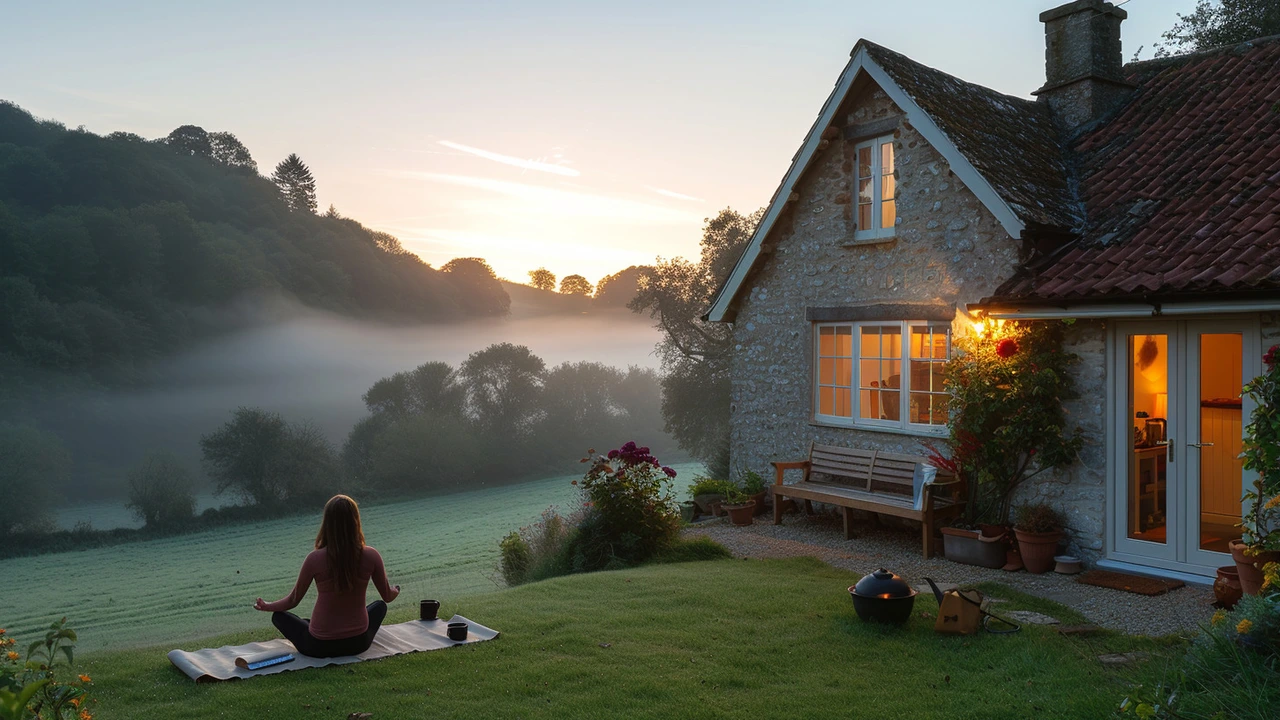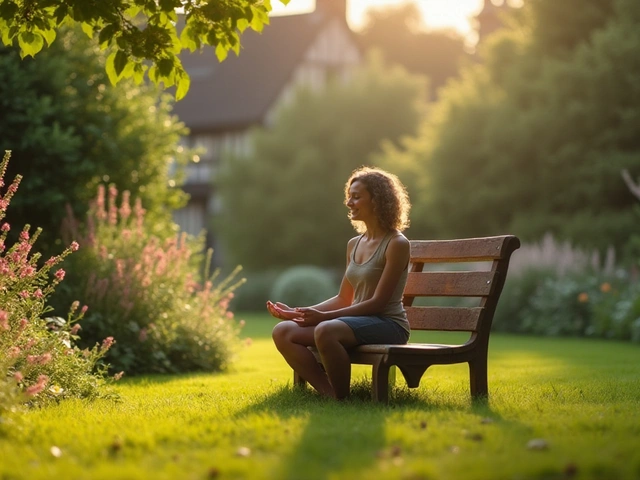Inner peace might sound like something out of a fairytale, especially in our fast-paced world. However, achieving a state of calmness is more reachable than many think. It all starts with understanding what inner peace really means and recognizing that it is a journey, not a destination.
In this article, you'll discover different methods to achieve a peaceful mind, including mindfulness practices and creating a tranquil environment around you. These aren't just theoretical ideas; they're practical tips that you can incorporate into your everyday routine to lead a more serene and fulfilling life.
Ready to start this journey to inner peace? Let's dive into the steps that can help transform your daily life.
- Understanding Inner Peace
- Mindfulness Practices
- Creating a Peaceful Environment
- Simple Daily Habits for Calmness
Understanding Inner Peace
Inner peace is often associated with a state of mental and emotional calmness, free from the pressures and worries that typically plague our daily lives. But at its core, inner peace is more than just an absence of stress; it is an active cultivation of serenity and contentment from within.
Many spiritual traditions and philosophies highlight the importance of achieving inner peace. For instance, Buddhism teaches the practice of mindfulness and detachment from desires as pathways to a peaceful mind. Similarly, Stoicism promotes understanding what we can control and letting go of what we cannot. These practices show that inner peace requires a deliberate and conscious effort to focus on the present moment and to accept reality without becoming overwhelmed by it.
Moreover, recent studies have shown that individuals who practice mindfulness and meditation experience lower levels of stress and improved mental health. According to a study published in the Journal of the American Medical Association, mindfulness meditation programs significantly reduced symptoms of anxiety, depression, and stress in participants. This scientific validation underscores the benefits of these ancient practices in our modern lives.
Inner peace is also closely linked to self-awareness. Understanding one's own emotions, triggers, and behavior patterns can pave the way to a more stable and balanced mind. Techniques like journaling, deep breathing, and reflective thinking can help in gaining deeper insights into oneself. Being aware of what disrupts your peace allows you to take proactive steps to protect and nurture it.
"Peace comes from within. Do not seek it without." – Buddha
Achieving inner peace doesn’t mean that you will never experience stress or hardship. Rather, it provides you with the tools and mindset to navigate life's challenges with grace and composure. It's about having resilience and finding your own oasis of calm amidst the chaos.
As we move forward, remember that the journey to inner peace is deeply personal. What works for one person may not work for another. It's crucial to explore different techniques and practices to find what resonates with you. Whether it's through meditation, spending time in nature, practicing gratitude, or simply taking a few minutes each day to breathe deeply, the goal is to find what helps you feel centered and at peace.

Mindfulness Practices
Mindfulness is all about being present in the moment and fully engaging with whatever you are doing. This concept, rooted in ancient meditation traditions, is now widely accepted as a powerful tool for achieving inner peace. One of the simplest ways to start practicing mindfulness is through mindful breathing. Focus on your breath as you inhale and exhale, paying attention to each sensation. Whenever your mind starts to wander, gently bring it back to your breathing.
Another effective method is mindful eating. This involves savoring each bite, noticing the flavors, textures, and even the colors of your food. It encourages you to slow down and truly enjoy your meals, which can have a calming effect on your entire body. In our fast-paced lives, many people eat on the go or while multitasking, which can disrupt digestion and increase stress levels.
Journaling is a mindfulness practice that helps you reflect on your thoughts and emotions. At the end of each day, take some time to jot down your feelings, what you are grateful for, and any experiences that stood out. This helps in identifying stressors and understanding your emotional landscape better. Scientific studies have shown that journaling can significantly reduce symptoms of anxiety and depression.
Introducing mindfulness meditation into your daily routine can also be transformative. Start by setting aside just five to ten minutes each day. Find a quiet, comfortable space and close your eyes. Focus on your breathing and let your thoughts come and go without judgment. Over time, you can increase the duration as you become more comfortable with the practice.
Mindfulness isn't limited to specific activities; it can be applied to any part of your day. Try being fully present while taking a walk, listening to a friend, or even washing the dishes. These moments, no matter how mundane, can become opportunities for mindfulness. As you develop this habit, you'll likely notice a reduction in stress and an increase in overall emotional well-being.
“Mindfulness means being awake. It means knowing what you are doing.” — Jon Kabat-Zinn
For some people, joining a mindfulness group can provide additional support and motivation. These groups often meet regularly for guided practices and discussions, creating a sense of community. Whether online or in-person, being part of a group can help you stay committed to your mindfulness journey.
Remember, the goal of mindfulness is not to eliminate stress but to develop a greater awareness of your thoughts and feelings. This awareness can help you respond to situations more calmly and thoughtfully rather than reacting impulsively. With consistent practice, you'll find that mindfulness becomes a natural part of your daily life, contributing to your inner peace.

Creating a Peaceful Environment
Creating a peaceful environment is essential for cultivating inner calmness. Your surroundings greatly influence your mental state, so let's look at some ways to turn your space into a sanctuary of peace. Start by decluttering. It's amazing how much mental stress a cluttered space can cause. When objects crowd your home, they crowd your mind too. Keep only what you need and love, and let go of items that don't serve a purpose or hold sentimental value.
Lighting plays a crucial role in creating a serene atmosphere. Natural light has been shown to improve mood and reduce stress. If possible, let in as much natural light as you can. Consider adding soft lighting—lamps with dimmable bulbs can create a cozy and calming atmosphere in the evenings. Avoid harsh, fluorescent lights that can cause eyestrain and increase stress.
Adding elements of nature can also bring a sense of calm to your surroundings. Houseplants not only purify the air but also have a soothing effect on our psyche. Research shows that interacting with plants can reduce psychological and physiological stress. Consider low-maintenance plants such as succulents or peace lilies if you don't have a green thumb.
Colors in your environment can have a significant impact on your mood. Soft, muted colors like blues, greens, and neutrals are known to promote relaxation and tranquility. You don't have to repaint your entire home; even small changes like adding cushions, throws, or artwork in these calming tones can make a difference.
Make your space personal. Fill it with things that make you happy and bring you peace, whether it's photos of loved ones, souvenirs from your travels, or artwork you adore. Personal touches can offer comfort and a sense of belonging. Incorporate scents that you find soothing as well. Essential oils such as lavender, chamomile, and eucalyptus have calming properties and can be used in diffusers or as sprays.
It's also important to have a dedicated space for relaxation and mindfulness. This might be a corner of your room with a comfortable chair and a good book, or a meditation space with cushions and candles. Having a specific area where you can unwind and practice mindfulness will make it easier to build calmness into your daily routine.
As Emma Seppälä, Science Director of Stanford University's Center for Compassion and Altruism Research and Education, states, 'Creating an environment that fosters peace can significantly enhance our well-being and improve our ability to manage stress.'

Simple Daily Habits for Calmness
Achieving inner peace doesn't require a huge overhaul of your life. Instead, it's often the small, consistent changes that make the biggest difference. One key habit to cultivate is starting your day with intention. Before reaching for your phone or diving into your to-do list, take a few moments to sit quietly and set a positive intention for your day. This practice helps you to focus your mind and prepare yourself for whatever lies ahead.
Another effective habit is incorporating mindfulness throughout your day. Mindfulness isn't just about meditation; it's about being present in whatever you're doing. Whether you're washing dishes, driving, or talking to a friend, being fully engaged can reduce your overall stress and increase your sense of peace. Dr. Jon Kabat-Zinn, the founder of Mindfulness-Based Stress Reduction (MBSR), once said,
“Mindfulness means paying attention in a particular way: on purpose, in the present moment, and non-judgmentally.”
It's also beneficial to take regular breaks, especially if you spend a lot of time in front of screens. Studies have shown that taking short, frequent breaks can greatly improve productivity and reduce mental fatigue. Step outside, stretch, or simply look away from your screen for a few minutes. This not only refreshes your mind but also helps you to remain calm and focused throughout the day.
Getting enough sleep is one of the pillars of maintaining a calm mind. Lack of sleep can make you feel irritable and stressed, while a good night's sleep can help you handle challenges with more ease. Try to develop a bedtime routine that signals to your body it's time to wind down. Avoid screens at least an hour before bed, opt for a soothing activity like reading or listening to soft music.
Physical activity is another powerful tool in your calmness toolkit. Exercise releases endorphins, which are natural mood lifters. You don't need to engage in intense workouts; even a simple walk can help clear your mind and boost your mood. Aim to move your body in a way that feels good for you. This might be yoga, dancing, or even gardening.
Don't underestimate the power of deep breathing. When you feel stressed, your body's fight-or-flight response kicks in. Deep, intentional breathing can activate your parasympathetic nervous system, which helps your body calm down. Try inhaling deeply through your nose, holding for a few seconds, and then exhaling slowly through your mouth. Doing this several times can have an immediate calming effect.
Lastly, consider nurturing positive relationships. Human connection is a vital part of our mental well-being. Spend time with loved ones, share your feelings, and listen to others. These interactions can provide you with a sense of community and support that is essential for maintaining calmness.






